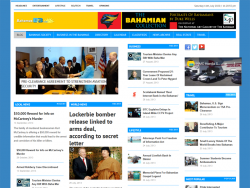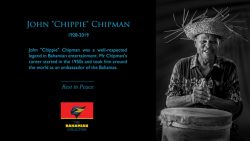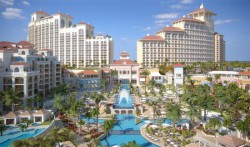In The Bahamas fishing is a major source of foreign exchange earnings as it is an economic activity approaching $100 million annually with exports to the United States and the European Union as the main markets. This industry is also a major employer as some 12,000 Bahamians find work as fishermen, fish vendors, boat owners or processing plant owners and workers. Its contribution to the country’s GDP is about 2%.
A. Geographical Description
The Commonwealth of The Bahamas has a shallow water area of some 116,550 Km 2 and consists of approximately 3,000 small islands and cays with a land area of about 13,935 Km 2 .These islands and cays are spread over an area of some 230,000 Km 2 and are located on 16 plateaus separated from each other and from Florida, Cuba and Hispaniola by depths of 200 – 2,000 fathoms.
The Bahamian fishing industry is confined to these shallow plateaus (Banks) and is notable for its diversity of species and clarity of water, rather than for high productivity, although standing stock and potential yield estimates compare favorably with estimates for comparable fishing grounds through the Caribbean.
B.Fisheries Policy
The Government of The Bahamas policy reserves the commercial fishing industry, as far, as is practical, for the exploitation by Bahamian Nationals. Commercial fishing vessels fishing within the Exclusive Economic Zone (EEZ) must be 100% Bahamian owned. Seafood processing facilities have been placed on the list of areas specifically targeted for overseas investors. Further, all investment projects with non-Bahamian interest must have the approval of the Government’s National Economic Council (NEC).
Earlier this week the Kerzner Marine Foundation (KMF) was launched here in The Bahamas.ᅠKerzner International intends to invest more than $5 Million over the next five yearsᅠto support the work of the Foundation. KMF is a newly established private nonprofit foundation that fosters the preservation and enhancement of the global marine ecosystems through scientific research, education and community outreach. The Foundation has initiated a programme to provide funding to The Bahamas National Trust and The Bahamas Sport Fishing Conservation Association and the Nature Conservancy.
The following article from Spore Magazineᅠon sea fishing outlines the developments in the African, Caribbean and Pacific (ACP) States of which The Bahamas is one.
June 11, 2005, saw a confrontation in Senegal between fishermen from Kayar and Guet Ndar. The toll: one dead and several wounded. The cause of the dispute: rivalry over access to an increasingly scarce resource – fish. Incidents of this kind are symptomatic of a serious problem. In August 2003, Spore sounded a cautionary note, urging the introduction of extensive political and economic changes if fish stocks were to be maintained. In March 2005, FAO confirmed that 75% of fishery resources had been fished to their maximum yield, over-exploited or exhausted.
Encouragingly, there is growing awareness of the need to move towards sustainable fisheries management, which combines long term viability with a strategy that satisfies the needs of fishers and ensures the economic development of resources. This has translated into a growing understanding, shared by all those involved, and in a range of measures, binding or otherwise, developed to regulate fishing. But there is still a long way to go before responsible and voluntary management of marine resources is adopted by all players in the fisheries sector. As long as stocks are over-exploited, and their profits diminished, fishers will continue to break the law. That was the clear message from several participants in an Internet debate organized by CTA in 2004.
Crucial for ACP states
The problem of fisheries surveillance is gradually being perceived as a major issue. Experts are coming up with acronyms such as IUU (illegal, unreported and unregulated fishing), MCS (monitoring, control and surveillance) and VMS (vessel monitoring system). In June 2005, a conference on the impact of illegal, unreported and unregulated fishing on developing countries was held in London. These developing nations are particularly badly affected, the meeting heard, because of a lack of funds, technical capacity, manpower, cooperation between states and, occasionally, of political will.
The countries of the South are not alone. Published last May, the European Commission’s annual report on serious breaches to the rules of the Common Fisheries Policy revealed that the number of infringements recorded rose from 6,756 in 2002 to 9,502 in 2003.
Five EU member states detected nearly 90% of all breaches. Unauthorized fishing accounted for 22% of the cases, while the figure for unlicensed fishing was 17%. A fine was imposed in 84% of cases. In 4,720 cases, fishing gear was seized.
The June 2005 bulletin of the Fisheries News Update section on CTA’s Agritrade website concluded that the report offered interesting lessons for ACP countries, noting that greater transparency over infringements and sanctions will increase confidence in the fair and equitable enforcement of regulations.
Fisheries infringements come in many guises, they include: fishing with unlicensed boats; and failing to land catches in local ports, in spite of the obligations of fisheries agreements and falsely reporting tonnage caught.
Whatever the measures taken, whether they are aimed at getting fishing zones respected, at better regulating fishing gear, at limiting the size of catches, at guaranteeing a biological rest period or at developing the economic activity of ports by making it mandatory to land all or part of catches locally, the notion of self-regulation appears to be an illusory one, and control measures are certainly needed. Some of these are already in place, and fall into two groups – so-called hardware and software measures.
By: Godfrey Eneas, The Bahama Journal



